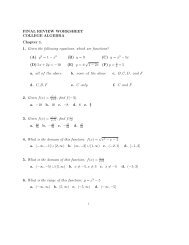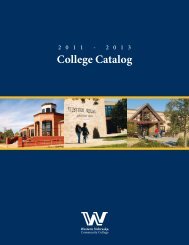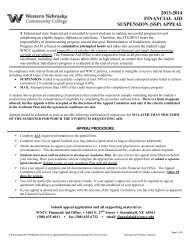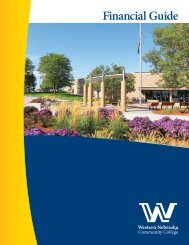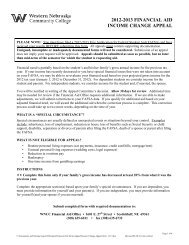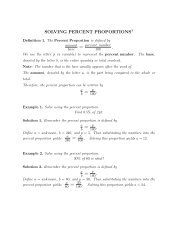WNCC 2010 Self-Study Report - Western Nebraska Community ...
WNCC 2010 Self-Study Report - Western Nebraska Community ...
WNCC 2010 Self-Study Report - Western Nebraska Community ...
Create successful ePaper yourself
Turn your PDF publications into a flip-book with our unique Google optimized e-Paper software.
Vice President of Educational Services<br />
Vice President of Outreach Education<br />
Dean of Educational Services<br />
Dean of Administrative Services<br />
Executive Director of Information Technology<br />
Director of Marketing and Public Relations<br />
<strong>WNCC</strong> Foundation Director<br />
Dr. Ely’s plan for the College’s organizational governance and administrative structure is<br />
highlighted in the organizational chart, which is presented in Appendix D of this document (RR 21).<br />
Communication Survey<br />
In January of 2009, a 32-question survey intended to gauge the current communication processes<br />
and strategies, as well as to gather information regarding alternative communication methods, was<br />
sent to members of the President’s Cabinet (RR 22). The administrative structure and organization<br />
of the President’s Cabinet had been in place for three semesters before the survey was<br />
administered.<br />
Results from the survey indicate that the new structures are perceived as working and are<br />
supportive of collaborative processes and effective leadership. Members of the President’s<br />
Cabinet have confidence in the restructured administrative and governance system at <strong>Western</strong><br />
<strong>Nebraska</strong> <strong>Community</strong> College. The equitable administration of policy at all sites surfaced as a<br />
challenge. Also, Cabinet members expressed a need to establish a balance between how much<br />
they work independently within their own department versus how much they share with others.<br />
Teamwork figured as a priority to those who answered the survey, and their commitment to the<br />
College is evident in their answers. As can be expected, the survey points out that teamwork and<br />
trust are sometimes not achieved perfectly, but given that members have worked together for a<br />
relatively short time under this new structure, there is opportunity for improved collaboration.<br />
Core Component 1e: The organization upholds and protects its integrity.<br />
<strong>Western</strong> <strong>Nebraska</strong> <strong>Community</strong> College has been in existence since 1926, but it officially became a<br />
public two-year institution in1932. Throughout those years, there have been challenges—the<br />
shrinking of the rural student population pool, issues of funding, and the task of trying to maintain<br />
integrity and community service. Because the College is relatively isolated from a large population,<br />
its faculty and leadership must be assertive and creative in promoting the College and instilling the<br />
belief among those served that the College is an excellent institution.<br />
The office of Human Resources, with direction from the Board of Governors Policy Manual, sets<br />
standards for hiring all faculty and staff. The College assures a comfortable workplace<br />
environment through a grievance policy, which is made available in the Faculty and Staff<br />
Handbook and on the <strong>WNCC</strong> website (RR 23).<br />
The mission outlines the need for students to become knowledgeable, responsible and active<br />
citizens of the educational community. They are provided with a Student Handbook, and they<br />
participate in New Student Orientation and are encouraged to connect with student organizations<br />
Page 56<br />
<strong>Western</strong> <strong>Nebraska</strong> <strong>Community</strong> College



